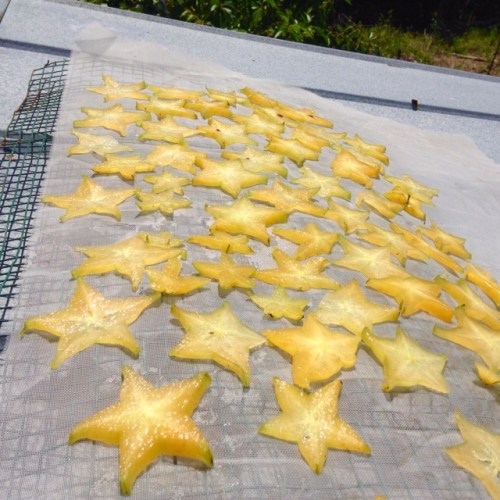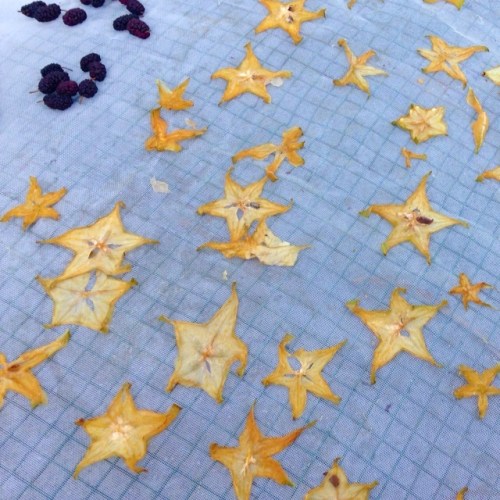
I love the idea of dehydrating fruit using only the power of sunlight. There are lots of electric food driers which can do this job adequately, but it takes a lot of electricity to generate sufficient heat to drive the water out of food. Solar energy can do the same job for free, and sunlight is creating heat every day anyway, whether we use it to do something useful or not.
Over the years, I’ve experimented with various designs of solar dehydrators, and none of them worked very well. (I’m not very mechanically inclined, so I probably didn’t do a very good job of constructing some of these designs I’d found online – apparently other people have gotten good results with some them.) Then one day I looked up and realized I already had an outstanding solar dehydrator: the metal roof of my house. I live in Florida, at a latitude about 29 degrees north of the equator (same latitude as the Sahara Desert), so the sun is intense here for much of the year – that roof turns blazing hot on sunny days.
Here’s the rooftop food-drying technique I’ve come up with, which reduces solar dehydration to its ultra-simple essentials. To keep the food raised slightly off the metal for air circulation and to keep it from contacting the roof directly, I first lay a sheet of wire mesh on the metal roof. Then on top of that I lay a sheet of food-grade plastic mesh (designed for use in dehydrators), and I spread thinly sliced fruit pieces on the plastic mesh. That’s it – the sun does the rest.
On a clear day, I can lay out slices of fruit around nine or ten oclock in the morning, and by the time shadows of nearby trees start reaching across the roof around four or five PM, thinly sliced pieces of fruit are completely dry to the point that they can go into jars for storage. Thicker slices of fruit and things which are naturally thicker like mulberries require a second day of dehydrating to get completely dry (I bring them in overnight so they don’t soak up night time dew).
I’ve used this technique with carambola (starfruit), mulberries, pears, blueberries, loquats, papayas, and even thinly sliced tangerines, and gotten excellent results.
When I first started experimenting with this method I thought I’d need to have some kind of mesh screen over the fruit to keep insects away. But so far I’ve found it doesn’t seem to be necessary: I’ve never seen an insect anywhere near the fruit while the sun is shining. It’s possible I’ve just been lucky, but I think it’s more likely that conditions are just too hot for insects on that blazing hot roof on a sunny day. Another thing I haven’t had a problem with yet is birds pecking at the fruit slices, despite birds being a constant nuisance pecking at fruit on the trees on the property. Here again, it’s possible I just might’ve been lucky so far, and the birds just haven’t discovered the fruit slices. But it’s also possible that it’s too hot for birds on that hot roof.
This method works best when the weather is clear all day. If the sky clouds up mid-day while I’ve got a batch of fruit slices on the roof, the dehydration process slows to a crawl, the roof temperature drops close to the day’s air temperature, and suddenly those slices of fresh, sweet fruit are much more tempting for birds and insects to access. I always check the weather forecast and only set out a batch of fruit slices when the day is predicted to be clear. In my area, we tend to get lots of clear, sunny days during the months of February through May, so that’s when I use this solar dehydration technique the most.
For materials, I’ve found the exact type of metal mesh is not important – I’ve gotten good good results with both hardware cloth, with holes about 1cm (.5 inch), and chicken wire, which has holes about 2.5cm (1 inch). Used sheets of metal mesh actually seem to work better than new: used sheets that I’ve pressed into a semi-flat shape always retain a few ripples, which helps keep the fruit slices raised up off the roof, while brand new sheets of metal mesh can lay too flat against the roof to do this job effectively without having a few ripples bent into it.

I use sheets of food-grade plastic mesh, designed for use in dehydrators, sold in rolls by online vendors. Since this is the surface that the edible fruits are actually contacting, I feel it’s good to be cautious here. It may very well be that other forms of mesh, including the kinds of metal or plastic mesh screen used over windows, might safely work just as well. But since I don’t know if they have any toxic components which could leach into the fruit slices, I stick to the mesh which has been tested to be safe in contact with food. This was the only real expense for me in setting up this system – I bought a roll of this mesh almost a decade ago, and I’ve been using it since.
My house has a metal roof, and that’s the only place I’ve tried this technique. Presumably other roof types could work well; I just don’t have any experience with them.
I find that temperatures get high enough with my rooftop dehydration method that fruit pieces can taste slightly cooked. I notice this especially with blueberries – when I sample them when they’re partially dried, they taste like the cooked blueberries that are in a blueberry muffin. I generally find this slight ‘cooked’ flavor to be pleasant: when I’ve tried this with pear slices, the dried fruit develops a wonderful aroma and flavor that reminds me of freshly-baked apple pie. I haven’t actually measured the temperature the fruit reaches, but I’m guessing that it’s high enough that the final product wouldn’t be considered “raw” for people sticking to a completely raw-foods diet.
The same thing is true for most electric food dehydrators, especially the inexpensive models which just have a heating element at the bottom, relying on convection for the heat to rise through trays of dehydrating fruit – these models often result dried fruit which tastes slightly “cooked”. There are more expensive models of electric dehydrator which tightly control temperature using fans and thermostats to keep temperatures from rising to cooking levels. For me personally, I eat a diverse diet including lots of cooked foods as well as lots of raw, so I’m fine with eating dried fruit that’s reached high temperatures.
It’s fun to able to use the power of sunlight not only to grow fruit, but also to use sunlight to convert seasonal abundances of fresh fruit into shelf-stable form, to extend my enjoyment of those fruits to much of the year.
I can’t believe this works for you!!! Do you lay anything over the fruit to protect from bugs? I have tried this several times on my white, blazing hot driveway and always always there are bugs and dust at the end of the day.
LikeLiked by 1 person
Yup, it works great, as long as it’s sunny all day. I wait till the roof is already getting full sun to lay out a batch of fruit. I thought at first I would meed a screen cover for bug protection, but I’ve done this with dozens of batches of fruit, and I’ve never seen a single insect on the fruit, or anywhere on the roof, while the sun is shining. I’m guessing there’s plywood under the roof metal and insulation under that, so the roof probably gets hotter than the driveway. I should measure the temp. I do try to get the fruit down the moment the sun’s no longer shining on it. Also I’ve never noticed even a trace of dust on the fruit – maybe being up high keeps it away from dust blowing around at ground level.
LikeLiked by 1 person
Great idea. I love sun dried fruit. Unfortunately it doesn’t work for us in the tropics.
LikeLiked by 1 person
I’ve gotten this to work during our summer rainy season, when temperatures and humidity are extremely high, and there’s a rainstorm most afternoons. The key is the metal roof that’s in full sun, which brings the temperature of the fruit much higher than the air temperature, driving moisture out of the fruit. We typically get sun from morning to early afternoon that time of year before the clouds come in, so that’s my window of opportunity for fruit drying. Sometimes it takes a couple of days to get it really dry enough for storage.
LikeLiked by 1 person
Would it work through glass? I might try it on a metal tray by my glass windows….
LikeLike
This drying process seems driven by heat – that metal roof gets way too hot to touch when the sun is shining. If a metal tray set in the sun by your windows gets extremely hot, it might be worth trying to dry some fruit slices on it. As always when dehydrating fruit, the thinner the slices, the faster they dry.
LikeLike
Isn’t it wonderful to harness the power of the sun! We do something similar using a baking tray on our steel boat roof. We probably should raise the fruits like you have to allow air underneath, but we didn’t think of that!
LikeLiked by 1 person
This is such a neat idea! I love the idea of drying fruit but the cost and electricity use of an electric dehydrator does not appeal to me at all. I have thought that the best option would be a DIY solar dehydrator made from wood. This is much easier, so it is worth a shot before getting involved in something more complicated.
LikeLiked by 1 person
Isn’t it remarkable that this technique works? When I first thought of it, I almost didn’t try it because I didn’t think something so simple could be effective.
One potential advantage of more elaborate solar dehydrators is that by relying more on air movement than solely on high temperatures, they might keep the food somewhat cooler, allowing more retention of heat-sensitive flavor compounds. But for foods that retain their flavor after exposure to near-cooking temps during drying, this method is a great, simple way to use the power of sunlight to convert fresh fruit into a shelf-stable form.
LikeLike
Awesome. I love this. 😍❤️❤️❤️
LikeLiked by 1 person